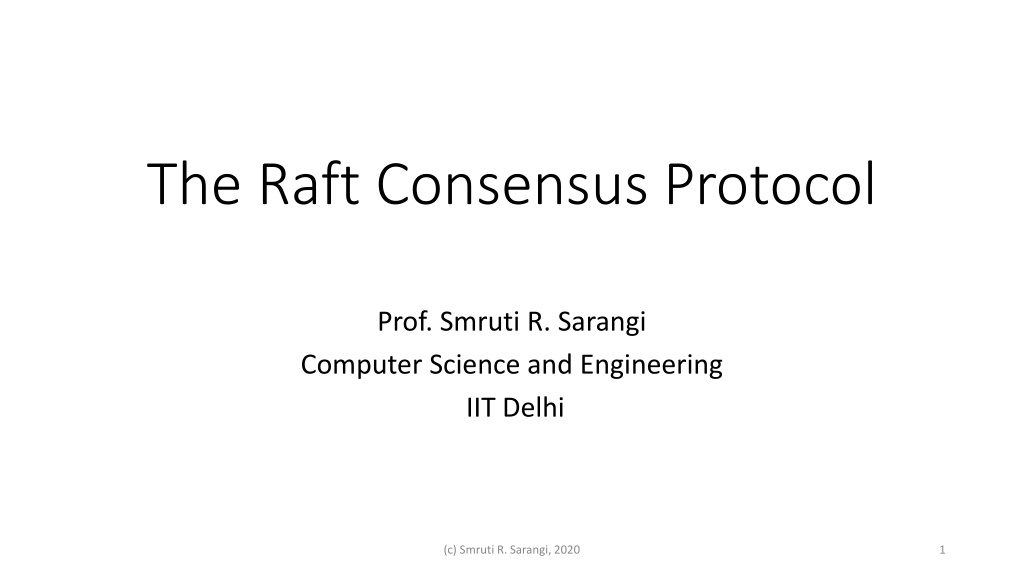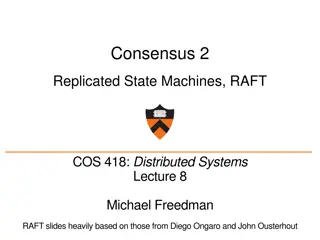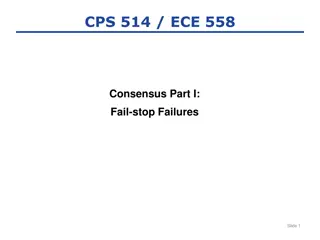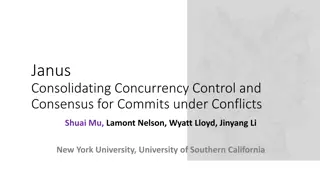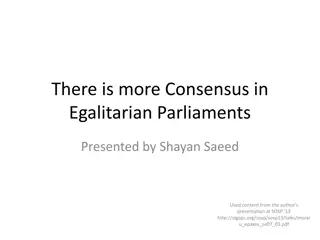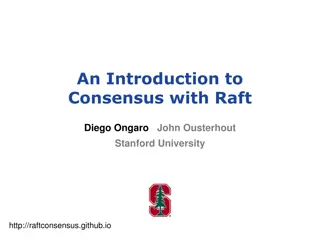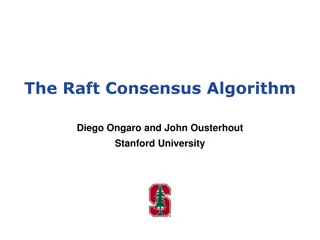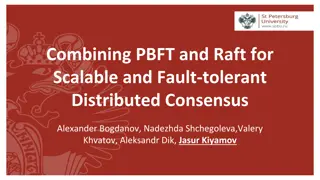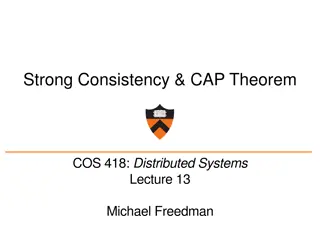Understanding the Raft Consensus Protocol
The Raft Consensus Protocol, introduced by Prof. Smruti R. Sarangi, offers a more understandable and easier-to-implement alternative to Paxos for reaching agreement in distributed systems. Key concepts include replicated state machine model, leader election, and safety properties ensuring data consistency. The protocol simplifies agreeing on sequences of events and maintaining consensus among servers in a cluster. By dividing time into terms and utilizing leader election mechanisms, Raft ensures a reliable and efficient distributed system operation.
Download Presentation

Please find below an Image/Link to download the presentation.
The content on the website is provided AS IS for your information and personal use only. It may not be sold, licensed, or shared on other websites without obtaining consent from the author. Download presentation by click this link. If you encounter any issues during the download, it is possible that the publisher has removed the file from their server.
E N D
Presentation Transcript
The Raft Consensus Protocol Prof. Smruti R. Sarangi Computer Science and Engineering IIT Delhi (c) Smruti R. Sarangi, 2020 1
Motivation Paxos is too complex Paxos is optimized for agreeing upon a single value If we want to agree upon a list of values (in the same order) such as a log It becomes even more complicated Practical implementations are unwieldy Main advantages of Raft Understandability Naturally tailored towards a list of values. Easy to implement (c) Smruti R. Sarangi, 2020 2
Overview (c) Smruti R. Sarangi, 2020 3
Key Idea Replicated state machine model Each server maintains a state machine Clients send requests to the servers All the servers need to apply the requests to their state machines in the same order (consensus order) This means that all the servers need to agree on the sequence of events (requests) Elect a leader It accepts requests from clients. Replicates them at the servers. Informs the servers when they can process the message (in consensus order) Divides time into terms: Each term has a unique leader and an increasing sequence number. (c) Smruti R. Sarangi, 2020 4
Safety Properties At most one leader can be elected at a given point in time (term). Election Safety It never overwrites or deletes entry in the log. Only appends new entries. Leader Append-Only If two logs contain the same entry at a given index and term. Logs are identical till that index. Log Matching If an entry is committed in a given term, it will be present in the logs of leaders of successive terms. Leader Completeness If a server has applied a log entry to a state machine, then all servers will apply the same entry at the same log index. State Machine Safety (c) Smruti R. Sarangi, 2020 5
A Raft Cluster Times out new election Receives votes from a majority of servers Times out, starts election Starts up Follower Candidate Leader Discovers the leader or a new term Discovers server with higher term A Raft cluster typically contains 5 servers A server has three states Leader, follower, and candidate Followers become candidates. Any candidate receiving a majority vote becomes a leader. If the leader finds another leader or a server with a higher term id, it becomes a follower again. (c) Smruti R. Sarangi, 2020 6
Dividing Time into Terms Term 2 Term 1 Term 3 Term 4 Leader election Normal operation Failed leader election Each server stores a current term number The term number is attached to every message If a server with a lower term number sends a message to a server with a higher term number, the latter rejects the message In the reverse case, the server with the lower term number upgrades its term num. If a candidate or leader discover that their term is stale, they move to the follower state. (c) Smruti R. Sarangi, 2020 7
Details (c) Smruti R. Sarangi, 2020 8
Leader Election All servers start in the follower state They periodically get messages from the leader Heartbeat messages If a server does not get a heartbeat for a pre-specified duration It times out Begins the process of electing a new leader Beginning an election Increments its current term Transitions to the candidate state Votes for itself. Sends a <RequestVote> message to rest of the servers. Three possible outcomes. (c) Smruti R. Sarangi, 2020 9
Three possible scenarios Each server votes for only one candidate in a given term. The leader needs to get a vote from the majority of servers. It begins its term, and sends heartbeat messages to the rest of the servers. Wins the election Receives an <AppendEntries> message from a server If the term is greater than or equal to the current term. Recognize the other server as the leader. Transition to the follower state. Otherwise, ignore the message. Each candidate times out and starts a new election. The timeout period is randomized. This minimizes the chances of having split votes. No leader is elected. Split votes. (c) Smruti R. Sarangi, 2020 10
Log Replication After a leader has been elected Clients send it requests. It sends <AppendEntries> messages to all the servers Structure of a log A list of entries Each entry stores a term number, and a command Each entry has an index (integer) to indicate its position in the log Committing an entry A log entry is committed once the leader has replicated it on a majority of servers. This commits all preceding entries as well. The leader includes the highest committed index in all its messages Once followers see the message, they commit their corresponding entries one after the other (in the order in which they are stored in the log) 11 (c) Smruti R. Sarangi, 2020
Log Matching Property - I Key safety properties (Log matching property) S1: If two entries in different logs have the same index and term, they store the same command. S2: If two separate logs have the same index and term, all the preceding entries of the logs are identical 1 3 Matched logs 2 4 5 7 6 Log index 1 1 2 2 3 3 3 Leader x 1 y 3 z 1 x 3 y 5 x 2 z 3 1 1 2 2 3 Follower x 1 y 3 z 1 x 3 y 5 1 1 2 2 2 Unmatched log x 1 y 3 z 1 x 3 z 3 (c) Smruti R. Sarangi, 2020 12
Log Matching Property - II Ensuring property S1 (same <index,term> same command) The leader creates at most one entry at a given index in a term This is sent to all the followers Property S2: (same <index,term> All previous entries match) Along with an <AppendEntries> message, the leader sends the <index,term> of the previous entry in its log. If the follower does not find the previous entry with a matching <index,term>, it refuses to accept the message Ensures the Log Matching property by induction It is possible that because of crashes, the follower s logs will diverge Raft forces followers to replicate the leader s logs. (c) Smruti R. Sarangi, 2020 13
Reconciling the Log Entries nextIndex = 8 7 1 3 6 5 2 4 Log index 1 1 2 2 3 3 3 x 1 y 3 z 1 x 3 y 5 x 2 z 3 The leader maintains a nextIndex pointer for each follower It is initialized to be equal to the index of the last entry in its log + 1 [Assuming the logs are consistent] Followers might indicate a divergence after receiving a message from the leader. The entries at (nextIndex 1) do not match. The leader decrements the nextIndex pointer and tries again Ultimately the logs match. The follower appends all the remaining entries from the leader s log. The leader never overwrites or deletes entries in its own log. It only appends. (c) Smruti R. Sarangi, 2020 14
Safety Properties (c) Smruti R. Sarangi, 2020 15
Leader Completeness Property Leaders will keep changing because of process crashes However, the new leader should have all the log entries of the old leader Election restriction A candidate cannot win an election unless its log contains all committed entries The <RequestVote> message includes information about the candidate s log The candidate s log should at least be as up to date as the log of the voter. Up to date check Check the last entries. The log with the higher term is more up to date. If the terms are the same, the log with more entries is more up to date. (c) Smruti R. Sarangi, 2020 16
Committing Entries from Previous Terms Assume a leader crashes Let s say it crashes before committing an entry, e, that is stored in a majority of servers. A new leader will be elected This leader s log has to be at least as up to date as a majority of the servers Let us say it has e in its log In the normal course of operation it will send e to the rest of the servers that do not have it. What about an entry from a previous term that is uncommitted? Should the current leader overwrite it, or commit it? Prefer simplicity: Do not commit entries from previous terms. (c) Smruti R. Sarangi, 2020 17
Follower and Candidate Crashes Raft keeps trying to send <RequestVote> and <AppendEntries> to all crashed followers and candidates All of Raft s messages are idempotent There is no harm if multiple copies of the same message are sent to the same server. Timing requirements: Broadcast time Election time out Mean time between failures Broadcast time: 0.5 to 20 ms Election timeout: 10ms to 500 ms (c) Smruti R. Sarangi, 2020 18
Proof of Safety (Leader Completeness Property) Say that in term T, leaderT commits an entry, e At a later term U, leaderU does not store the entry Consider the smallest such U. U > T e must have been absent from U s logs at the time of its election There must be some server, S, that accepted e (sent by leaderT) and also voted for leaderU. S still had e, when it voted for leaderU. This is because all the intervening leaders had e in their logs (assumption, we chose the smallest U). At the time of voting, leaderU s log must have been up to date If they had the same last term, then the log of leaderU must have been longer. It must have contained e. (c) Smruti R. Sarangi, 2020 19
Proof of Safety - II Otherwise, leaderU s last log term must have been larger than the voter s. The earlier leader that created leaderU s last log entry must have had e in its log (assumption). By the Log Matching property , leaderU s log must also contain e. Hence, the Leader Completeness Property holds. (c) Smruti R. Sarangi, 2020 20
Miscellaneous Issues (c) Smruti R. Sarangi, 2020 21
Cluster Membership Changes Servers can get added or deleted from the Raft cluster. The traditional approach is to stall the system. Copy the logs to the new configuration. Restart the system. Raft does this without any down time. Leader receives a request to change the configuration: Cold Cnew It creates a joint consensus mechanism Creates a new configuration Cold,new. It broadcasts this message to all the servers. Once the Cold,new entry has been committed, all the servers have to respect this joint configuration. (c) Smruti R. Sarangi, 2020 22
Joint Consensus Mechanism Cnew Cold,new Cold During this period, the servers act in a special way Log entries are replicated in all the servers. Any server (from Cnew or Cold) can be elected as a leader We need separate majorities (election and entry commitment) in both the old and new configurations. This ensures that the new servers in Cnew can get all the logs. New servers can also join as non-voting members. After this the leader sends a message to all the servers describing Cnew After this message is committed, a server from Cnew needs to start an election and win. This will happen because all the logs till this message are committed. (c) Smruti R. Sarangi, 2020 23
Log Compaction Logs will keep growing over time. When a log reaches a fixed size, take a snapshot. Store a snapshot of the entire follower server in stable storage Record the index, and term of the latest entry in the last snapshot Then discard the stored logs from the servers Servers take snapshots independently by the leader and followers The leader may send snapshots to followers that are far behind (c) Smruti R. Sarangi, 2020 24
Client Interaction Clients first contact a randomly chosen server, that directs them towards the leader Linearizability consistency condition: Each request appears to execute in a single instant at some point between its invocation and response Every command is assigned a unique serial number by the client. Servers keep a record of it. If they see a command once again, they simply respond to it without re- executing the request. Read-only operations Can be handled without writing anything to the log Before executing a read-only operation, the leader needs to ensure that it has at least committed a single message in the current term, and it is still the leader. (c) Smruti R. Sarangi, 2020 25
References 1. Ongaro, D., & Ousterhout, J. (2014). In search of an understandable consensus algorithm. In 2014 {USENIX} Annual Technical Conference ({USENIX}{ATC} 14) (pp. 305-319). (c) Smruti R. Sarangi, 2020 26
Thank you (c) Smruti R. Sarangi, 2020 27
